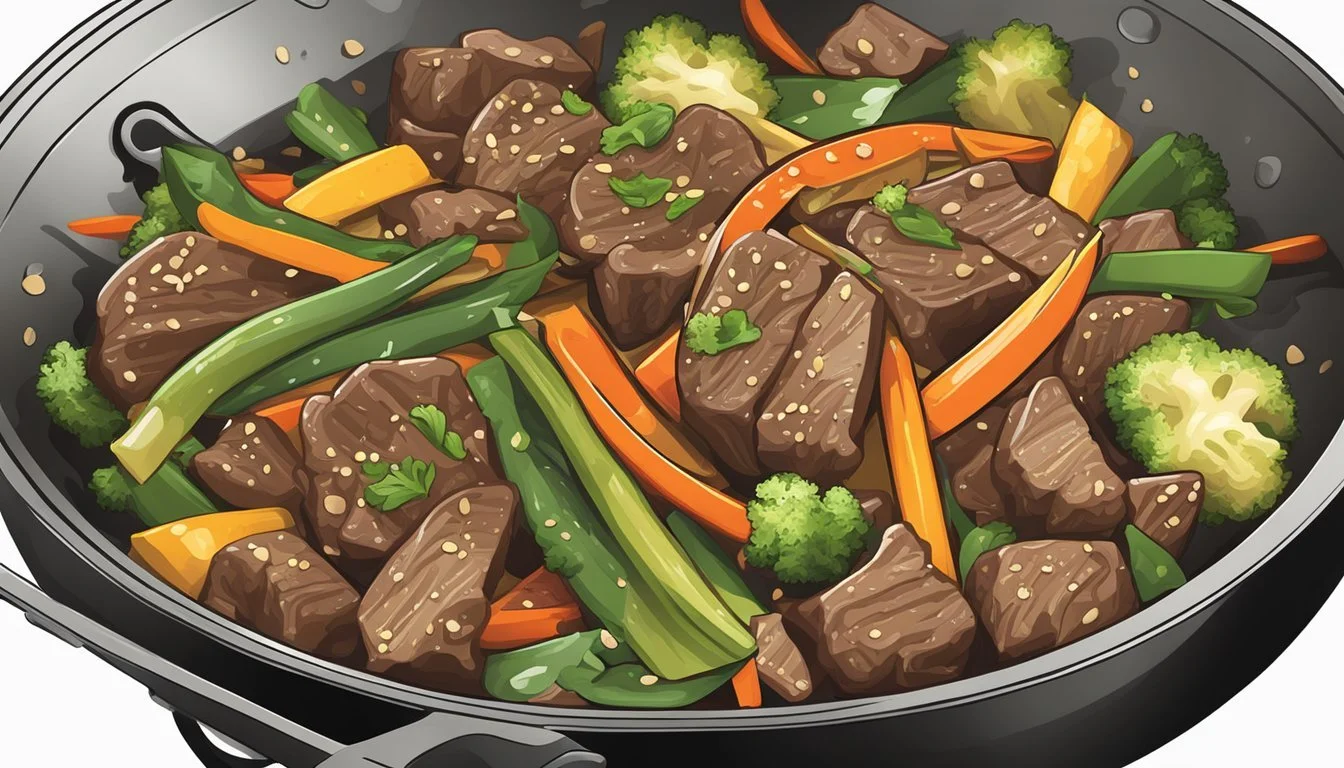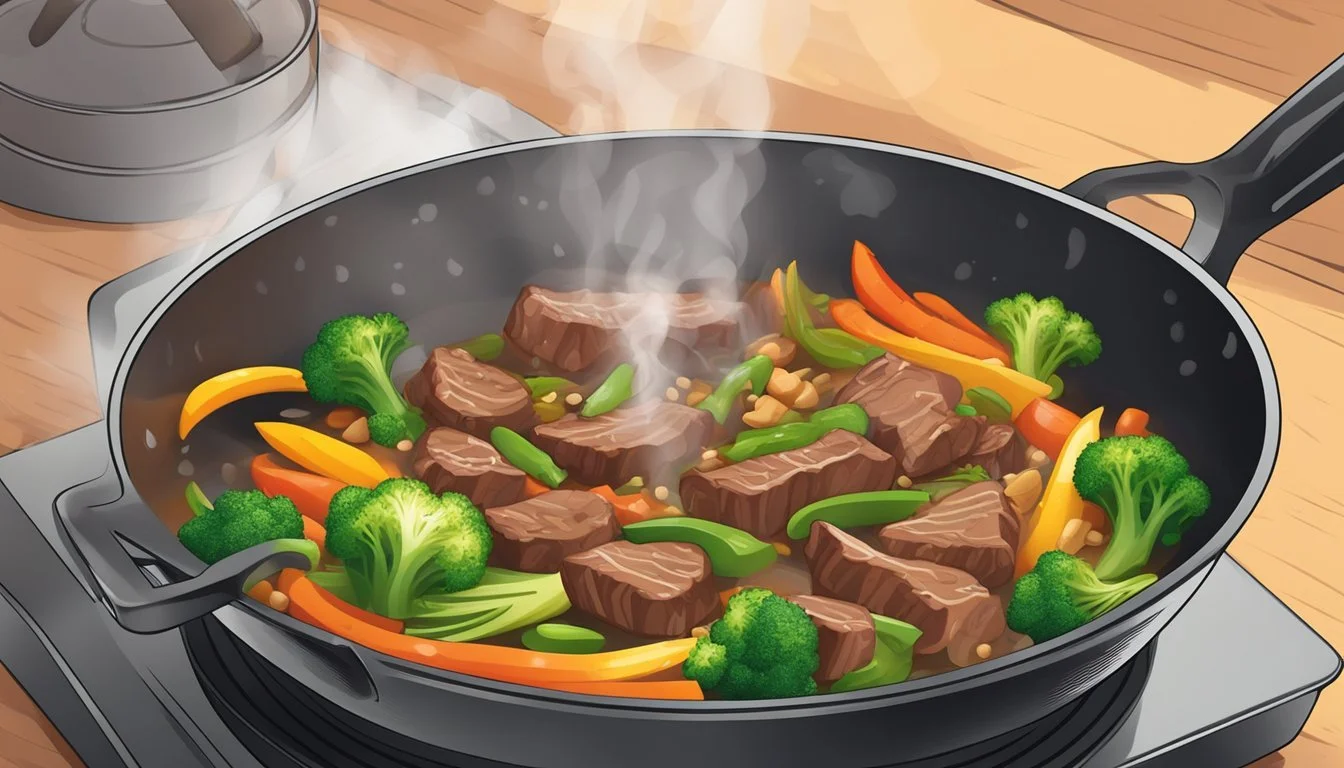Best Way to Reheat a Beef Stir-Fry
Keeping Veggies Crisp and Fresh
Beef (What wine goes well with beef?) stir-fry is a delightful dish that combines the savoriness of meat with the freshness of vegetables, all wrapped in a flavorful sauce. The challenge of reheating a beef stir-fry lies in maintaining the texture of the vegetables and the tenderness of the beef without overcooking either component. Reheating methods need to be carefully selected to ensure that the stir-fry's essence is preserved, with vegetables that are crisp and meat that is just as succulent as when it was first cooked.
When dealing with leftover stir-fry, the key is to apply heat that brings the dish back to the desired temperature while preventing any further cooking that could affect its quality. Conventional methods, such as using a microwave or oven, often run the risk of turning the vegetables soft and the beef chewy. However, with the right technique, one can revive the stir-fry to a state that rivals its freshly cooked form. The approach should be gentle and attentive, capitalizing on the balance between heat and time.
Understanding how different components of a stir-fry react to heat will guide the reheating process. Beef should be succulent and vegetables should retain a bite, as these textures are crucial to the authenticity of a stir-fry. Ideal reheating techniques involve a quick application of heat to the dish, whether it is by using a stove, an oven, or a microwave, with certain modifications to ensure even warming without overdoing it. Each method has its nuances and choosing the right one can make all the difference in enjoying a delicious reheated beef stir-fry.
Understanding Reheating Stir Fry
When one decides to reheat a beef stir-fry, the aim is to restore the dish's flavors and textures close to its freshly cooked state while ensuring that it is safe to consume. Here we explore the dynamics of reheating and the common problems that can arise.
The Science of Reheating
Reheating beef stir-fry involves applying heat to make the food sufficiently hot for consumption, which ideally should reach 165°F to ensure safety. Different heating methods affect the dish's moisture, flavor, and texture. Here are the primary ways to reheat:
Microwave: Quick and convenient, best done at medium power to avoid drying out the dish. It heats food using dielectric heating, but can result in uneven heating.
Stovetop: Offers more control, allowing for consistent reheating and the ability to add moisture if needed. Reheat over medium heat, stirring frequently.
Oven: Suitable for even reheating, covered with foil in a baking dish at 350°F to retain moisture. Takes longer but tends to preserve flavors well.
Air fryer: While not commonly used for reheating stir-fry, it can be effective if done at lower temperatures with quick tossing to prevent drying.
Each method has an impact on the stir-fry's texture, with careful temperature management being key to maintaining quality.
Potential Reheating Pitfalls
Certain issues typically arise during the reheating process, especially concerning texture and safety:
Overcooking: High heat or prolonged reheating can lead to tough beef and soggy vegetables. One must use the right amount of heat and reheating duration.
Dryness: Loss of moisture can occur, especially with the microwave or oven. Adding a splash of water or broth can counteract this problem.
Uneven heating: Especially prevalent in the microwave, where some food parts can be hot while others remain cold, potentially leading to foodborne illnesses. Stirring and rotating the food halfway through the heating time can promote even reheating.
Cross-contamination: One should ensure the stir-fry is heated to a uniform and safe temperature to kill any potential bacteria.
By understanding the science behind reheating and recognizing potential pitfalls, one can effectively reheat beef stir-fry while preserving its desired qualities.
Preparation for Reheating
Proper storage and preparatory steps are crucial for successfully reheating beef stir-fry without overcooking the vegetables. These practices ensure that the flavors and textures are preserved before the reheating process begins.
Storage Tips
After cooking, one should allow their beef stir-fry to cool completely to avoid condensation which can make the vegetables soggy. Once cooled, the dish should be transferred to an airtight container to prevent any moisture loss or odor absorption from other foods in the refrigerator. To maintain the integrity of the vegetables and beef, store the leftovers in the refrigerator promptly.
Cooling Time: Wait until the stir-fry reaches room temperature.
Container: Use an airtight container for storage.
Refrigerator Temperature: Keep the fridge at or below 40°F (4°C).
Pre-Reheat Prep
Before reheating, one should remove the beef stir-fry from the refrigerator and let it sit at room temperature for a few minutes. This helps to reduce the temperature gradient, aiding in more even reheating and helping to preserve the texture, especially of the vegetables. If the stir-fry appears dry, adding a tablespoon of water or broth can reintroduce moisture.
Room Temperature Rest: Let the stir-fry sit for 10-15 minutes before reheating.
Moisture Check: Add liquid if the stir-fry seems dry.
Reheating Techniques
To ensure the beef stir-fry retains its texture and flavors, one must use appropriate reheating techniques. This prevents vegetables from becoming soggy and meat from drying out. Here are the best methods to consider.
Microwave Method
Using a microwave-safe dish, spread the beef stir-fry evenly. It's vital to cover the dish with a paper towel to promote even heating and avoid splattering. Reheating should be done on medium heat in intervals of 90 seconds, checking regularly to prevent overcooking.
Stovetop Method
The stovetop provides great control over heat. Begin by preheating a pan on medium heat. Transfer the stir-fry to the pan and stir frequently. One can add a small amount of water or broth if needed to add moisture and prevent the dish from drying.
Oven Reheating
An oven will evenly heat the stir-fry without making it soggy, provided one uses low heat (around 350°F) and covers the dish with foil to retain moisture. Spreading the stir-fry in a single layer on an oven-safe dish and reheating for 10-15 minutes is recommended.
Using an Air Fryer
An air fryer can reheat stir-fry effectively by combining rapid air movement and high heat. Place the stir-fry in the basket, taking care not to overcrowd, and heat in short intervals at 350°F. This method is fast and helps to maintain the texture of the stir-fry.
Avoiding Common Mistakes
Reheating beef stir-fry requires careful attention to detail to preserve its texture and flavor. The reader should learn how to prevent the dish from becoming soggy or burning while maintaining the quality of the meat and vegetables.
Preventing Sogginess
To avoid a mushy texture, chefs must not over-saturate the stir-fry. They should reheat the dish on a medium-low heat setting and add only a small amount of oil or water if necessary. It is also wise to keep the container uncovered for some time during reheating to allow excess moisture to escape.
Tips to prevent sogginess:
Do not reheat at high temperatures.
Refrain from adding too much liquid.
Maintaining Meat and Vegetable Quality
Reheating the stir-fry should simultaneously ensure that the meat remains tender and the vegetables retain their crispness. Chefs recommend stirring intermittently to prevent sticking and monitoring closely to avoid overcooking, which can lead to a loss of texture and flavor.
Best practices for quality:
Stir gently and periodically.
Observe the stir-fry closely to prevent vegetables from becoming mushy.
Sauce and Seasoning Adjustments
Lastly, the sauce may thicken upon cooling, so chefs may need to adjust the seasoning. When reheating, they might add a bit of water or broth to thin out the sauce, but they should take care not to dilute the stir-fry's flavor.
Considerations for adjustments:
If sauce is too thick, a small amount of liquid can help.
Balance is critical – avoid weakening the sauce's robust taste.
Final Touches
After reheating the beef stir-fry, one may wish to restore the dish to its peak condition by enhancing the texture and flavor. These final adjustments can make a noticeable difference, ensuring the dish is enjoyable as the first time it was served.
Restoring Crispiness
To bring back the crispiness of the vegetables, a brief sauté on high heat can be effective. They should use a small amount of oil such as peanut oil or vegetable oil due to their high smoke points. Here are two simple steps:
Heat the Oil: In a pan, heat a tablespoon of peanut or vegetable oil over high heat.
Quick Sauté: Toss the vegetables in the pan for no more than one minute.
Remember, the goal is to re-crisp, not to cook them further.
Seasoning and Flavor Enhancement
A stir-fry can lose some of its robust flavors after reheating. To compensate, they may need to enhance the seasoning. Adding a splash of soy sauce can intensify the umami flavor. For a nutty aroma, a drizzle of sesame oil just before serving does wonders. They should consider these tips:
Soy Sauce: Add a teaspoon of soy sauce and stir well.
Sesame Oil: Finish with a few drops of sesame oil to elevate the flavors.
By paying attention to these details, one ensures that the beef stir-fry retains its intended flavors and textures.
Alternative Approaches
Reheating beef stir-fry need not compromise freshness or flavor. Integrating new ingredients when reheating can revitalize the dish, adding both texture and nutrition.
Adding Freshness with Vegetables
One can introduce fresh vegetables to the beef stir-fry to bring back a crisp, vibrant texture. Here are specific steps to ensure the best outcome:
Blanch the vegetables: Quickly blanche fresh veggies like carrots or broccoli in boiling water, then add them to the stir-fry during the final minutes of reheating.
Saute separately: Stir-fry additional vegetables such as bell peppers or snow peas in a separate pan before adding them to the reheated beef and sauce, which maintains their crunch and color.
Incorporating New Proteins
Incorporating different proteins can transform leftovers into a new and flavorful dish. Consider these options:
Tofu: Pan-fry cubes of tofu until golden and mix them into the stir-fry as it's being reheated.
Meat: Add prepared chicken or thinly sliced beef to bring variety and extra protein to the dish, creating a more complete and satisfying meal.
By reheating with care and creatively adding additional components like fresh veggies or new proteins, leftover stir-fry can be more than just a repeat — it can become an entirely new culinary delight.
FAQ on Reheating Stir Fry
When reheating stir fry, one aims to maintain the dish's appeal and ensure food safety. This section addresses frequently asked questions, focusing on optimal reheating techniques, safety precautions, and management of leftovers while handling Chinese food (What wine goes well with Chinese food?) or any takeaway that uses stir-fry cooking.
Best Practices
Safe reheating temperatures: Ensure the stir fry reaches 165°F internally to be considered safe for consumption.
Methodology: Use a skillet over medium heat for an even reheat, adding a splash of water or oil to prevent drying out and retaining the texture of the vegetables and beef.
Addressing Safety Concerns
The following points are pivotal when reheating stir fry to prevent the proliferation of bacteria:
Store leftovers quickly: Place the stir fry in an airtight container and refrigerate within two hours of cooking.
Reheat only once: Reheating multiple times can compromise the quality and safety of the stir fry.
Dealing with Leftovers
Refrigeration: Refrigerate leftovers in shallow, airtight containers to expedite cooling and reduce the risk of bacteria growth.
Consumption timeframe: Ideally, consume refrigerated leftover stir fry within 3-4 days to ensure it remains fresh and safe.






